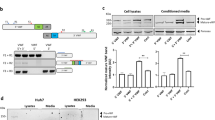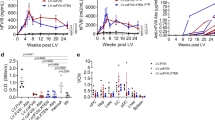Abstract
The liver is one of the prime targets for gene therapy, and the correction of defects in a variety of clotting factor genes is one of the main goals of liver-directed therapies. The use of transcriptional regulatory elements derived from these genes may provide for the optimal expression of transduced genes. We have applied our knowledge of the promoter structure of the clotting Factor IX gene to design optimized expression vectors for use in gene therapy. The activity of the proximal promoter has been augmented by the introduction of a multimerized upstream site which we have previously shown to be a prime regulator of the pro- moter. Introduction of this element increases promoter activity at least 20-fold over the proximal promoter alone when assayed in the human liver cell line Hep G2. This optimized promoter is significantly more active than the SV40 enhancer/early promoter. The expression of the optimized Factor IX promoter is also more persistent in the short term. The inclusion of a liver-specific locus control region, derived from the apolipoprotein E/C locus, did not further augment expression levels. These Factor IX vectors also exhibit a high degree of tissue specificity, as measured by transfection into breast and muscle cell lines.
This is a preview of subscription content, access via your institution
Access options
Subscribe to this journal
Receive 12 print issues and online access
$259.00 per year
only $21.58 per issue
Buy this article
- Purchase on Springer Link
- Instant access to full article PDF
Prices may be subject to local taxes which are calculated during checkout






Similar content being viewed by others

References
Sandig V, Strauss M . Liver-directed gene transfer and application to therapy J Mol Med 1996 74: 205–212
Eisensmith RC, Woo SL . Viral vector-mediated gene therapy for hemophilia B Thromb Haemostas 1997 78: 24–30
Snyder RO et al. Persistent and therapeutic concentrations of human factor IX in mice after hepatic gene transfer of recombinant AAV vectors Nat Genet 1997 16: 270–276
Guo ZS, Wang LH, Eisensmith RC, Woo SL . Evaluation of promoter strength for hepatic gene expression in vivo following adenovirus-mediated gene transfer Gene Therapy 1996 3: 802–810
Nakai H et al. Adeno-associated viral vector-mediated gene transfer of human blood coagulation factor IX into mouse liver Blood 1998 91: 4600–4607
Loser P, Jennings GS, Strauss M, Sandig V . Reactivation of the previously silenced cytomegalovirus major immediate–early promoter in the mouse liver: involvement of NFkappaB J Virol 1998 72: 180–190
Ponder KP et al. Evaluation of relative promoter strength in primary hepatocytes using optimized lipofection Hum Gene Ther 1991 2: 41–52
Hafenrichter DG et al. Quantitative evaluation of liver-specific promoters from retroviral vectors after in vivo transduction of hepatocytes Blood 1994 84: 3394–3404
Okuyama T et al. Liver-directed gene therapy: a retroviral vector with a complete LTR and the ApoE enhancer-alpha 1-antitrypsin promoter dramatically increases expression of human alpha 1-antitrypsin in vivo Hum Gene Ther 1996 7: 637–645
Reijnen MJ, Bertina RM, Reitsma PH . Localization of transcription initiation sites in the human coagulation factor IX gene FEBS Lett 1990 270: 207–210
Picketts DJ, Lillicrap DP, Mueller CR . Synergy between transcription factors DBP and C/EBP compensates for a haemophilia B Leyden factor IX mutation Nat Genet 1993 3: 175–179
Thompson AR . Structure, function, and molecular defects of factor IX Blood 1986 67: 565–572
Briet E, Bertina RM, van Tilburg NH, Veltkamp JJ . Hemophilia B Leyden: a sex-linked hereditary disorder that improves after puberty New Engl J Med 1982 306: 788–790
Crossley M et al. Recovery from hemophilia B Leyden: an androgen-responsive element in the factor IX promoter Science 1992 257: 377–379
Boccia LM, Lillicrap D, Newcombe K, Mueller CR . Binding of the Ets factor GA-binding protein to an upstream site in the factor IX promoter is a critical event in transactivation Mol Cell Biol 1996 16: 1929–1935
Reijnen MJ et al. Hemophilia B Leyden: substitution of thymine for guanine at position-21 results in a disruption of a hepatocyte nuclear factor 4 binding site in the factor IX promoter Blood 1993 82: 151–158
Drazan KE, Wu L, Bullington D, Shaked A . Viral IL-10 gene therapy inhibits TNF-alpha and IL-1 beta, not IL-6, in the newborn endotoxemic mouse J Pediatr Surg 1996 31: 411–414
Grosveld F et al. The dynamics of globin gene expression and gene therapy vectors Ann NY Acad Sci 1998 850: 18–27
Allan CM, Taylor S, Taylor JM . Two hepatic enhancers, HCR.1 and HCR.2, coordinate the liver expression of the entire human apolipoprotein E/C-I/C-IV/C-II gene cluster J Biol Chem 1997 272: 29113–29119
Allan CM, Walker D, Taylor JM . Evolutionary duplication of a hepatic control region in the human apolipoprotein E gene locus. Identification of a second region that confers high level and liver-specific expression of the human apolipoprotein E gene in transgenic mice J Biol Chem 1995 270: 26278–26281
Picketts DJ, Mueller CR, Lillicrap D . Transcriptional control of the factor IX gene: analysis of five cis-acting elements and the deleterious effects of naturally occurring hemophilia B Leyden mutations Blood 1994 84: 2992–3000
Friedman AD, Landschulz WH, McKnight SL . C/EBP activates the promoter of the serum albumin gene in cultured hepatoma cells Genes Dev 1989 3: 1314–1322
Li X, Eastman EM, Schwartz RJ, Draghia-Akli R . Synthetic muscle promoters: activities exceeding naturally occuring regulatory sequences Nat Biotechnol 1999 17: 241–245
Maire P, Wuarin J, Schibler U . The role of cis-acting elements in tissue-specific albumin gene transcription Science 1989 244: 343–346
Picketts DJ, Mueller CR, Lillicrap DP . Transcriptional control of the factor IX gene: analysis of five cis-acting elements and the deleterious effects of naturally occurring hemophilia B Leyden mutations Blood 1994 84: 2992–3000
Acknowledgements
We would like to acknowledge the financial support of the Toronto Hospital for Sick Children Extramural grant program and of the Canadian Hemophilia Society. We would also like to thank David Lillicrap for critical reading of the manuscript. CRM was supported by a National Cancer Institute of Canada Research Scientist award during part of this work.
Author information
Authors and Affiliations
Rights and permissions
About this article
Cite this article
Hoag, H., Gore, J., Barry, D. et al. Gene therapy expression vectors based on the clotting Factor IX promoter. Gene Ther 6, 1584–1589 (1999). https://doi.org/10.1038/sj.gt.3300985
Received:
Accepted:
Published:
Issue Date:
DOI: https://doi.org/10.1038/sj.gt.3300985


